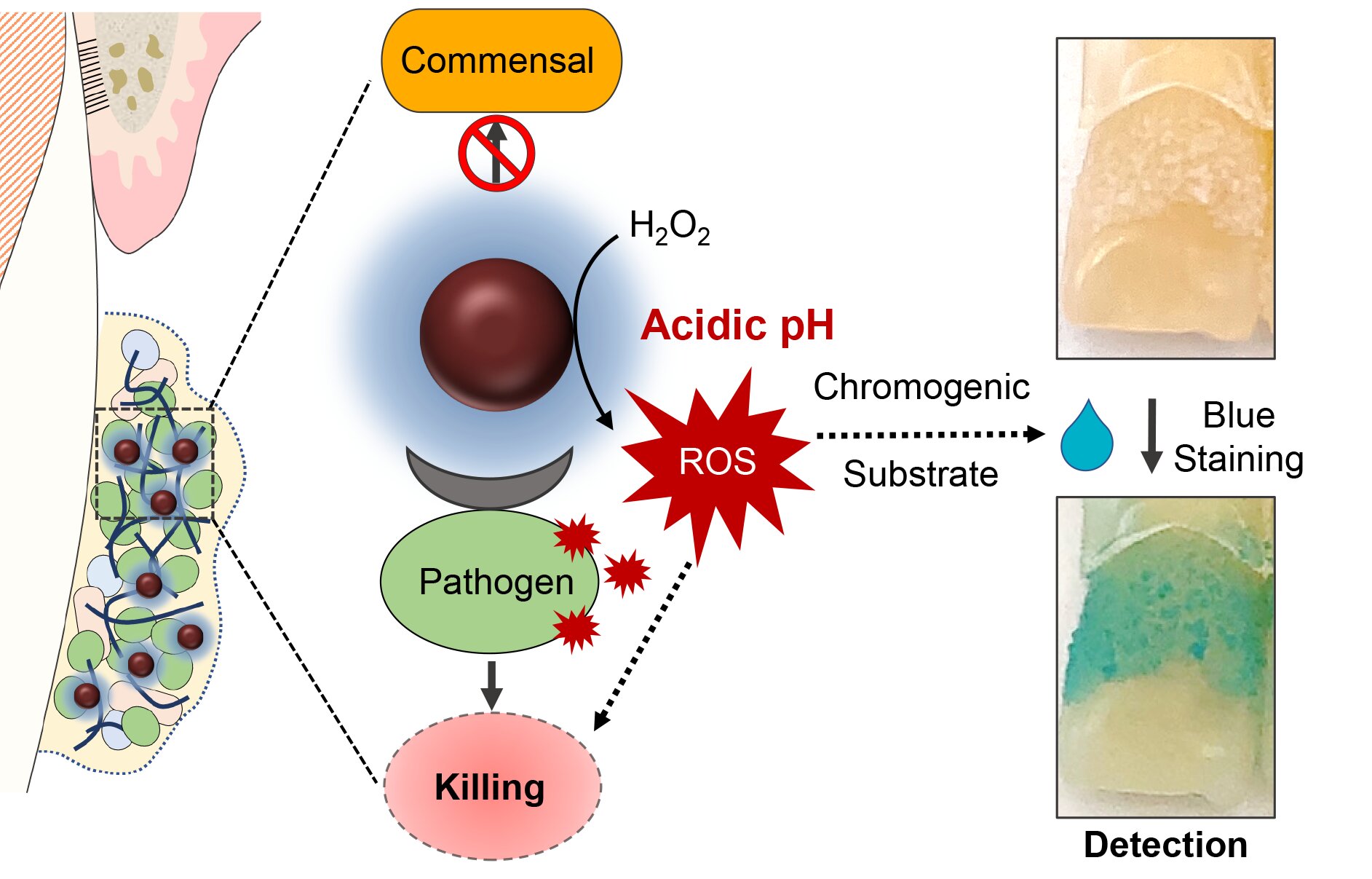
According to a new study, iron oxide nanoparticles paired with hydrogen peroxide result in a targeted treatment that kills harmful oral bacteria, breaks down dental plaque and diagnoses harmful oral biofilms. Credit: Image courtesy of the study authors
Evidence is mounting that there is a connection between severe tooth decay and iron-deficiency. Although it is not clear if the link is causal or correlative, both conditions are often associated with poor diets. They are also more common in those who live in poverty and have underlying medical conditions.
Research from Indiana University and the University of Pennsylvania suggests that a FDA-approved treatment for iron-deficiency is also possible to treat, prevent, or diagnose dental decay. The therapeutic, a combination of an iron-oxide nanoparticle-containing solution called ferumoxytol and hydrogen peroxide, was applied to real tooth enamel placed in a denture-like appliance and worn by the study subjects.
The results of the study were published in Nano Letters. They found that twice daily use of ferumoxyl (which activates hydrogen peroxide in a follow up rinse) significantly reduced dental plaque buildup and had a targeted effect upon the bacteria responsible for tooth decay. These nanoparticles have enzyme-like properties and are being increasingly explored for biomedical and environmental uses.
Hyun Michel Koo, a professor at the University of Pennsylvania School of Dental Medicine, says that "we found that this approach was both precise and efficient." It disrupts biofilms, especially those created by Streptococcus Mutans, which can cause caries. It also reduces the amount of enamel decay. This is the first clinical study to demonstrate the therapeutic potential of nanozymes in fighting an infectious disease.
The work is an extension of a 2018 paper published in Nature Communications, in which Koo and colleagues, including David Cormode of Penn's Perelman School of Medicine, showed that the iron oxide nanoparticle-hydrogen peroxide treatment could prevent biofilm accumulation and tooth-decay in an experimental model and an animal model.
The scientists in the current study wanted to move on to human research. They had 15 participants try a removable denture-like device that has real tooth enamel attached. This method was developed by Domenick Zero, an Indiana University co-author of the current paper.
Participants applied a sugar-containing solution four times per day to the appliance, in an attempt to mimic high-sugar snacks and meals. The enamel specimens were not to be brushed, but rather rinsed twice daily. Participants were divided into three groups: one group used the ferumoxytol rinse followed by the hydrogen peroxide rinse; one with a solution that contains the inactive ingredients of ferumoxytol; one with water alone.
The biofilms formed on enamel specimens were examined by the researchers after 14 days. The experimental treatment was able to reduce the growth of biofilms containing S.mutans. It could also kill the bacteria with high specificity. The ferumoxytolhydrogen peroxide treatment did not affect other commensal bacteria that are normally found in the mouth.
Previous research has supported the safety and effectiveness of this approach. It showed that iron oxide nanoparticles don't bind to mucosal tissue in a mouth and does not cause cytotoxicity.
Koo states that the treatment does not appear to have any harmful or off-target effects.
This precision comes from three factors. This reaction to catalyze hydrogen oxide can only occur in highly acidic environments, such as those created by active caries-causing bacteria. The treatment causes the sticky matrix made up of carbohydrates to be broken down. This exposes the microbes and degrades the biofilm. Ferumoxytol is able to bind specifically to the receptors on S. mutans' cell membrane, which facilitates its destruction.
The researchers also added a blue marker to the study that changes color when exposed to reactive oxygen compounds, such as those produced by the catalysis by hydrogen peroxide using ferumoxytol Nanoparticles. The team discovered that blue labeling intensity was related to acidic biofilms containing S.mutans.
Koo says that this experimental treatment could be a "theranostic" - a drug that can both diagnose and treat a condition. Koo states that it can be used at home. You could use it to rinse, check for cavities, then either treat the area with the solution, or visit a dentist for further treatment.
Continue reading Dental plaque is not a match for catalytic nanoparticles
More information: Yuan Liu and colleagues, Ferumoxytol nanoparticles target biofilms Causing Tooth Decay in the Human Mouth. Nano Letters (2021). Information from the Journal: Nano Letters, Nature Communications Yuan Liu, Ferumoxytol Nanoparticles target Biofilms Causing Tooth Deay in Human Mouth, (2021). DOI: 10.1021/acs.nanolett.1c02702
